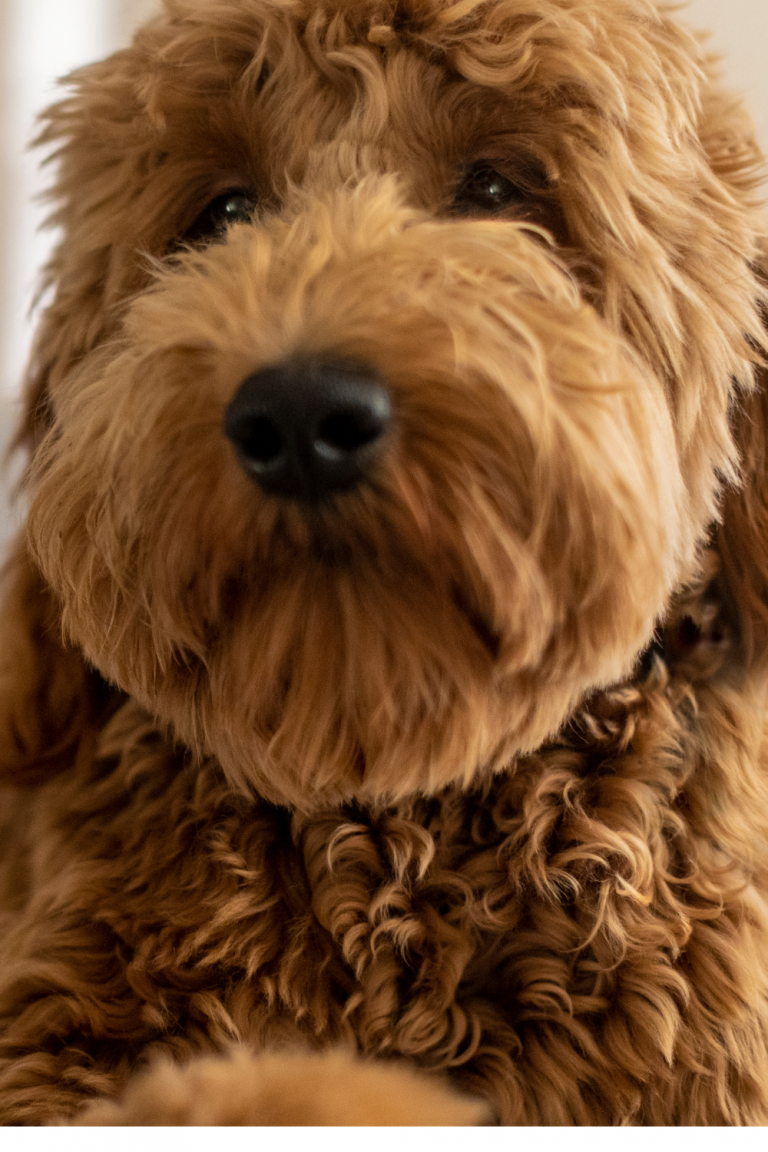
Goldendoodles and Labradoodles are super cute, friendly and popular. They both love their people. Labs, Golden Retrievers, and Poodles are three of the world’s most popular dogs.
The first difference between a Goldendoodle and a Labradoodle is their lineage. A Goldendoodle is a mix of a Golden Retriever and a Poodle; whereas, a Labradoodle is a Labrador Retriever crossed with a Poodle.
With both Goldendoodles and Labradoodles, people desire the non-shedding coat of the Poodle along with the Poodle’s intelligence. Additionally crossing two breeds creates hybrid vigor, which tends to make a healthier breed.
Most of the differences between the two breeds stem from the differences in the Labrador and Golden Retriever breeds.

Appearance
Labradoodles look different from Goldendoodles because they are born with coats of different colors and consistency.The Labrador Retriever has a coarser and thicker hair follicle. A Labradoodle will typically have shorter and wirier fur that comes in a larger variety of colors.
Labradoodle’s coat naturally comes in yellow, black, chocolate, white, cream or red. However, since it’s part Poodle, they sometimes come in some of the fun Poodle variations such as parti, brindle, merle, and parti-colored coat. Many first generation Labradoodles shed because of their wiry coat.
Golden Retrievers have a thinner hair follicle. Because they have more hair overall, they tend to have a fluffier and wavy look. Golden Retrievers naturally have cream, caramel, gold, or red colored puppies. Since Poodles come in all colors, Goldendoodle puppies can be those colors plus black, chocolate, parti, brindle, merle, etc. A first generation Goldendoodle will usually have longer and wavy fur.
Due to their attractive appearance and desirable personality traits, both the Labradoodle and Goldendoodle are extremely popular. They are especially popular among people with allergies, as with proper breeding, they should shed much less than other breeds. The lack of shedding means these dogs are far less likely to trigger allergic reactions.
Grooming
Due to differences in their coats, the Labradoodle and Goldendoodle have different grooming requirements.
Labradoodle puppies need to be brushed regularly, as their adult coats often do not grow in until they are approximately a year old. Regular brushing prevents matting and keeps the puppy’s coat healthy. Once your puppy is used to brushing, it’s a good idea to start giving it regular trims with a pair of scissors. To ensure the dog’s safety, use scissors with rounded tips, especially when you trim the hair on the face.
If you decide to take your Labradoodle to a groomer, be sure to provide detailed grooming instructions before the dog’s first appointment. Labradoodles should be groomed in a specific way, especially if you want your dog to maintain its trademark Labradoodle appearance. For example, the groomer should use a long blade to trim the bulk of the coat. The Labradoodle is meant to have full-looking legs, so the groomer must be careful not to trim off too much hair. For best results, trim your Labradoodle’s nails once or twice per month.
Goldendoodles need regular grooming. Otherwise, your dog’s adorable features will quickly be obscured by long hair. When trimming the coat, you have a few options when it comes to length. Some owners prefer to trim the hair so it’s the same length all over the body, with the exception of the feet, face and tail. How long you leave the hair is up to you, but remember that longer hair tends to get matted, which means you’ll need to brush your Goldendoodle frequently if you decide to leave the hair long. Another option is to keep your Goldendoodle’s hair short all over, which makes it easier to keep the dog clean. A short cut is also more comfortable during the hot summer.
Temperament
Both Goldendoodles and Labradoodles are moderately energetic, friendly and great family dogs. There are slight differences between the two. Goldendoodles are usually more friendly and enthusiastic with a happiness that lasts until the next morning.
Goldendoodles seem like they can never stop wagging their tails. Some Labradoodles are a bit more reserved than Goldendoodles but in a loyal way. Labradoodles are less likely than Goldendoodles to make as many new friends. Labradoodles are extremely loyal to their families and are still energetic and playful dogs. In general a Goldendoodle is more quick to approach a complete stranger, whereas a Labradoodle will typically stay closer to his/her “person.”
Labradoodles are like your high school senior class president, who is confident, dependable, and love to have a task to handle.
Goldendoodles are like your high school senior class Personality (maybe even the class clown). Goldendoodles are like the Senior who was always telling jokes, and the life of the party.
Labradoodles are great service dogs (seeing eye Labradoodles, Labradoodles to help those in wheelchairs, etc.). Goldendoodles are great therapy dogs.
If you want a Doodle to go into a nursing home, hospital, or elementary school, a Goldendoodle can make an excellent pet to meet new people, create lots of smiles, and giggles.
Activity Level
Labradoodles are high-energy dogs that need lots of exercise. A fenced-in backyard is ideal, but long walks, runs, or hikes will help this active breed release energy and stay on track. They also enjoy agility training, tracking, and herding.This active breed is known for their love of the water thanks to their retriever genes. Generally speaking, because of their high activity level, Labradoodles don’t do well in apartment settings.
Goldendoodles may not require quite the same level of exercise as Labradoodles, although they are still energetic dogs that require about 30 minutes of moderate exercise per day. They can also keep up with an active family and can enjoy longer runs or hikes. Goldendoodles love the water and enjoy a good swim and particularly, a game of fetch in the water. Anecdotally, they can be mellower than Labradoodles, although they like to be with their owners as often as possible.
Both Doodles are friendly, loyal, and affectionate. Both dogs live for companionship and need plenty of exercise, companionship, and stimulation. Ask lots of questions about a litter’s specific parentage, which will give you the most information about size and temperament.
Similarities
Both Labradoodles and Goldendoodles are highly intelligent, and both make excellent family pets. If you are searching for a pet for either a family with young children or for a sweet companion for a couple who is a little older in age, either a Goldendoodle or Labradoodle would be an excellent choice.
They are also both incredibly effective guide or therapy dogs, while Labradoodles are bit more apprehensive in new environments they are still wonderful guide or therapy dogs when trained correctly. With proper training or the opportunity to grow up in a loving family Goldendoodles and Labradoodles are beautiful, loving pets with a high aptitude for learning, an infectious exuberance, and a huge heart for people.
Size
Goldendoodles vary in appearance. A standard Goldendoodle is about 22 inches high and ranges in size from 55 to 70 pounds. However, there are also miniature Goldendoodles that weigh in between 35 and 50 pounds, and toy Goldendoodles that can be as small as 20 pounds.
Labradoodles similarly have varying weights and colors, depending on parentage. The standard size is between 50 and 65 pounds with a height between 22 and 24 inches. A medium Labradoodle is slightly smaller, with a height of around 18 to 20 inches, and a weight of around 30 to 45 pounds.
Health and Life Span
As a mix of the Poodle and the Labrador Retriever, a Labradoodle can have health problems that are common in either breed. Labrador Retrievers and Poodles often develop hip dysplasia. ways. With proper care, the typical life span of a Labradoodle is 15 years, making this breed an excellent choice for a long-term companion.
Since Goldendoodles are part Poodle, they may also develop hip dysplasia as they get older. Eye conditions and a narrowing of the aortic valve are also possible, as these conditions are associated with Golden Retrievers. Again, working with a reputable breeder can help you reduce the risk of these problems, as quality breeders are vigilant about using only the best dogs for breeding purposes. Goldendoodles have an expected life span of 10 to 15 years.
Cost
High-quality doodles typically cost between $1,500 and $3,500. The cost depends on several factors, such as location, the health testing performed on the parents, the food/healthcare expenses, the breeder’s reputation for excellence, standing by their health guarantee, etc.
If you’re looking for a Labradoodle or Goldendoodle to add to your family, remember that the cost is a reflection of the breeder’s reputation and the quality of the puppies available. Quality is important, as good breeding practices can help you avoid common health problems and ensure you get to enjoy many years with your new companion.
All Doodle dogs vary, depending on their parents, nutrition, loving family, health check-ups, lifestyle and a healthy dose of luck!

